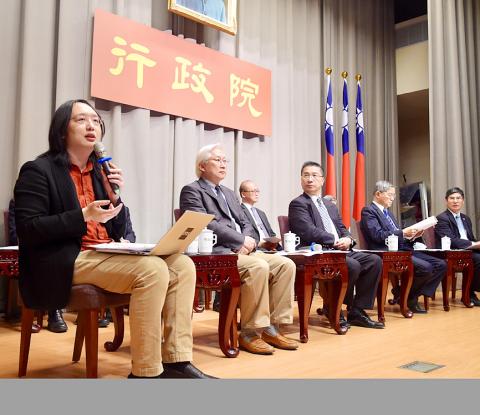The Executive Yuan yesterday announced plans to invest NT$46.056 billion (US$1.51 billion) over the next eight years to improve the nation’s digital infrastructure and bridge the rural-urban divide.
The plan — part of the government’s “Forward-looking Infrastructure Construction Project” — aims to improve rural access to broadband Internet, as well as develop a 5G mobile services network by 2020 and an Internet of Things (IoT) network.
Officials told a news conference they are aiming for 90 percent coverage of broadband services nationwide, with rural access speeds to be in the megabytes per second range.

Photo: Huang Yao-cheng, Taipei Times
The plan also calls for enhancing information security, improving a disaster-relief communications system and developing a cloud-computing system for public education.
National Development Council Minister Chen Tain-jy (陳添枝) said that government investment in the expansion of broadband Internet would spur more investment from private enterprises, which is estimated to reach NT$238 billion.
National Communications Commission spokesman Wong Po-tsung (翁柏宗) said that the country has already stepped up preparations to activate a 5G network, adding that IoT technology would be the next major development.
“In the future, truly everything will be connected to the Internet,” Wong said.
Facilitating broadband access to rural communities is essential to safeguard the right to equal access for all, especially those who live in remote areas, Wong said.
Minister Without Portfolio Audrey Tang (唐鳳) said that pervasive megabyte-speed Internet access is the trend, and rural communities cannot be left behind.
Officials said artists and other creative content producers would benefit from higher-speed broadband services, which would allow for the transmission of high-definition images and video content.
Government digital storage facilities will be upgraded to allow the storage of higher-definition content, while use of digital networks will be promoted among content producers.
The announcement described plans for promoting interest in technology by connecting schools to virtual classrooms and installing interactive systems at technology parks.
Officials said they hoped to foster interest in innovation and creative content design among students.
Minister Without Portfolio Wu Tsung-tsong (吳政忠) said that Taiwan’s communications and technology industries used to place more emphasis on hardware, but the focus is now shifting to digital design.
The government hopes to see hardware, software and content be better integrated, Wu said, adding the future would see the promotion of such things as artificial intelligence and driverless cars.
Content and application services will grow increasingly important, Wu said.
Asked about IoT, Tang compared it with the development of air pollution and earthquake monitoring systems, which have become more accurate and efficient.
In the future all of the information people need will be available at once, which will boost the deployment of these technologies, Tang said.
Deputy Minister of Education Lin Teng-chiao (林騰蛟) said that he looks forward to using a portion of the new special budget to purchase new equipment for classrooms and install fiber Internet connections in schools.

The US government has signed defense cooperation agreements with Japan and the Philippines to boost the deterrence capabilities of countries in the first island chain, a report by the National Security Bureau (NSB) showed. The main countries on the first island chain include the two nations and Taiwan. The bureau is to present the report at a meeting of the legislature’s Foreign Affairs and National Defense Committee tomorrow. The US military has deployed Typhon missile systems to Japan’s Yamaguchi Prefecture and Zambales province in the Philippines during their joint military exercises. It has also installed NMESIS anti-ship systems in Japan’s Okinawa

‘WIN-WIN’: The Philippines, and central and eastern European countries are important potential drone cooperation partners, Minister of Foreign Affairs Lin Chia-lung said Minister of Foreign Affairs Lin Chia-lung (林佳龍) in an interview published yesterday confirmed that there are joint ventures between Taiwan and Poland in the drone industry. Lin made the remark in an exclusive interview with the Chinese-language Liberty Times (the Taipei Times’ sister paper). The government-backed Taiwan Excellence Drone International Business Opportunities Alliance and the Polish Chamber of Unmanned Systems on Wednesday last week signed a memorandum of understanding in Poland to develop a “non-China” supply chain for drones and work together on key technologies. Asked if Taiwan prioritized Poland among central and eastern European countries in drone collaboration, Lin

NO CONFIDENCE MOTION? The premier said that being toppled by the legislature for defending the Constitution would be a democratic badge of honor for him Premier Cho Jung-tai (卓榮泰) yesterday announced that the Cabinet would not countersign the amendments to the local revenue-sharing law passed by the Legislative Yuan last month. Cho said the decision not to countersign the amendments to the Act Governing the Allocation of Government Revenues and Expenditures (財政收支劃分法) was made in accordance with the Constitution. “The decision aims to safeguard our Constitution,” he said. The Constitution stipulates the president shall, in accordance with law, promulgate laws and issue mandates with the countersignature of the head of the Executive Yuan, or with the countersignatures of both the head of the Executive Yuan and ministers or

CABINET APPROVAL: People seeking assisted reproduction must be assessed to determine whether they would be adequate parents, the planned changes say Proposed amendments to the Assisted Reproduction Act (人工生殖法) advanced yesterday by the Executive Yuan would grant married lesbian couples and single women access to legal assisted reproductive services. The proposed revisions are “based on the fundamental principle of respecting women’s reproductive autonomy,” Cabinet spokesperson Michelle Lee (李慧芝) quoted Vice Premier Cheng Li-chiun (鄭麗君), who presided over a Cabinet meeting earlier yesterday, as saying at the briefing. The draft amendment would be submitted to the legislature for review. The Ministry of Health and Welfare, which proposed the amendments, said that experts on children’s rights, gender equality, law and medicine attended cross-disciplinary meetings, adding that